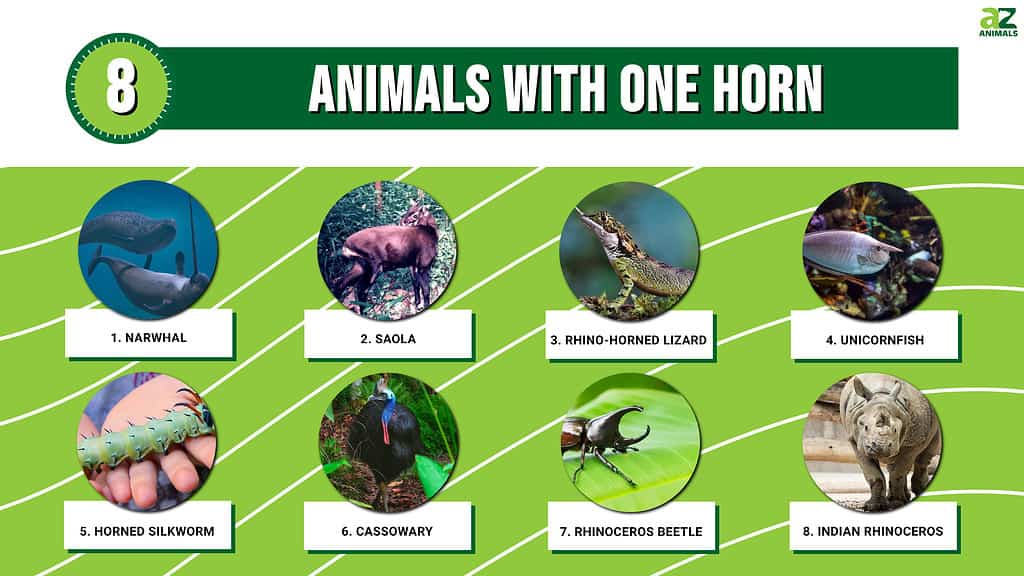
All animals have their special characteristics and features. Some are known for, or even named after a certain feature. That’s true for many of the animals on this list. The following eight animals share the characteristic of having just one horn.
Some animals listed here use their horn to protect themselves while others use them to hunt for and kill prey. Interestingly, a few of the animals on this list have baffled scientists for decades. They can’t figure out why these animals have a horn! Keep reading to discover eight animals with one horn and what they use it for.
#8 Indian Rhinoceros

©iStock.com/Stefan Rotter
The Indian rhinoceros (Rhinoceros unicornis) makes the list due to the large horn on its snout. Its horn can measure 8 to 25 inches in length and is a mixture of keratin and hair. Incidentally, a human’s fingernails are also made out of keratin! This rhino has a few purposes for its single horn.
It uses its single horn to intimidate predators and threats. These rhinos have a mild nature and want to avoid a battle. So, they lower their heads to the ground and charge in the general direction of a predator to show dominance. The threat could be another rhinoceros or perhaps a tiger. In many cases, the other animal is scared off by the charging rhino. They are fast and tough! But, if the predator remains, the rhino uses its single horn to defend itself against attack. Its horn is a sharp, effective defensive weapon.
Rhinos rub their horn on the ground and on trees which scrapes away a soft exterior layer of the horn leaving sharp edges behind. Not surprisingly, its horn can cause serious or deadly injury to another rhino or a tiger.
Indian rhinos sometimes use their one horn for digging in the hard soil in search of vegetation to eat. It’s also used to dig into dry creek beds in search of water. Female rhinos use their horn to direct their young calves along through their grassland habitat.
#7 Rhinoceros Beetle

©iStock.com/rawintanpin
A rhinoceros beetle gets its name from the large, single horn on its head. This insect has a brown or gray exterior and can measure up to six inches long. It lives in areas all over the world except the continent of Antarctica. This insect is also known as the Hercules beetle because of its great strength. They can lift twigs, vegetation, and other objects over 800 times their size! What do these beetles use their horn for? Well, it has a few purposes.
Male rhinoceros beetles use their horn to fight other males when competing for females. In addition, these beetles use their horn to dig through piles of leaves and other debris on the ground. If a rhinoceros beetle feels threatened, it can use its horn to dig into the soil and hide until the threat is gone.
#6 Cassowary
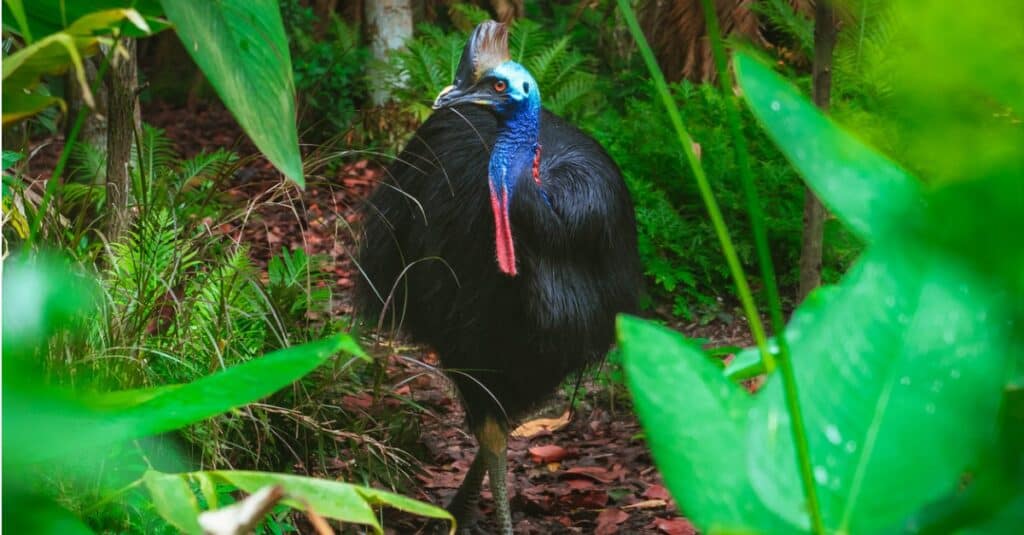
©iStock.com/Henry Soon
The first thing you notice about a cassowary is the bright blue, red, and purple of the skin on its neck. The second thing you notice is the large horn atop its head. This horn is also called a casque. It has an inner layer of soft, spongy material and an outer layer of keratin. If you were to squeeze its horn, it would be soft in its middle portion. How exactly does the cassowary use its one horn?
The answer: Scientists are not sure. One theory is this bird bends its head and uses its horn to move through the dense vegetation and huge leaves in its tropical forest habitat in Australia. Another theory is a cassowary’s horn is a sign of the maturity or dominance of a bird. Both males and females have this single horn, though females usually have a larger one.
The cassowary need not use its horn as a defense mechanism due to its powerful weapon: the claw. Its strong, dagger-like nails can slice open a predator in a flash. In fact, there are two human fatalities recorded due to cassowary injuries.
#5 Horned Silkworm
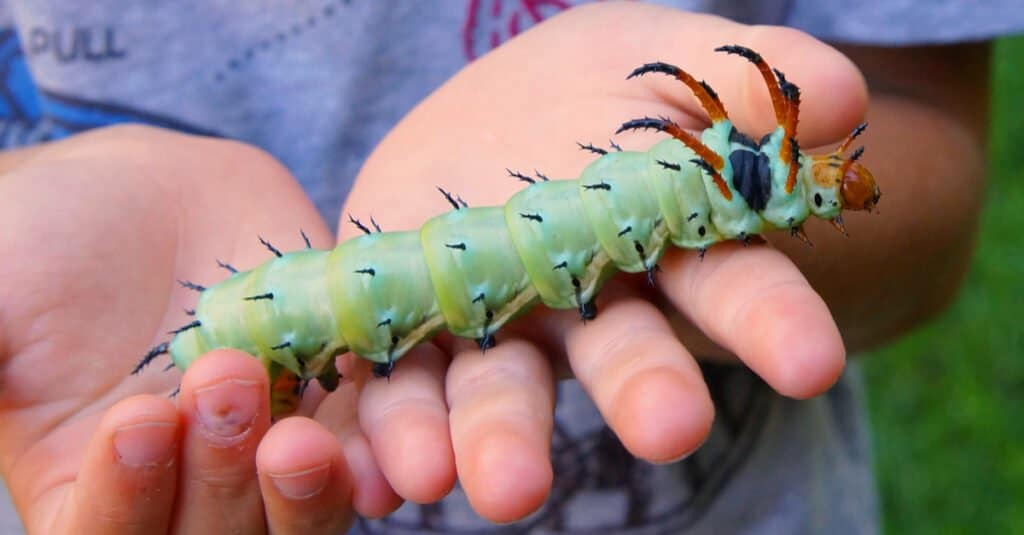
©Matt Jeppson/Shutterstock.com
The horned silkworm is a brightly colored caterpillar measuring around three inches in length. This caterpillar turns into a silkworm moth. It has one horn on the tail end of its body. Though it appears to be a sharp horn, it is very soft and bendable. This one horn serves an important purpose for this small insect.
As you may have guessed, this caterpillar is at risk of being gobbled up by many predators. Birds, spiders, and paper wasps are just a few of the animals that eat horned silkworms. Its horn serves as a sign for predators to keep away. A predator may be deterred by what it thinks is a sharp horn that will hurt if it tries to eat the silkworm. Do horned silkworms fool a lot of predators into leaving them alone? Yes! This is why the population of this silkworm has continued to flourish.
#4 Unicornfish
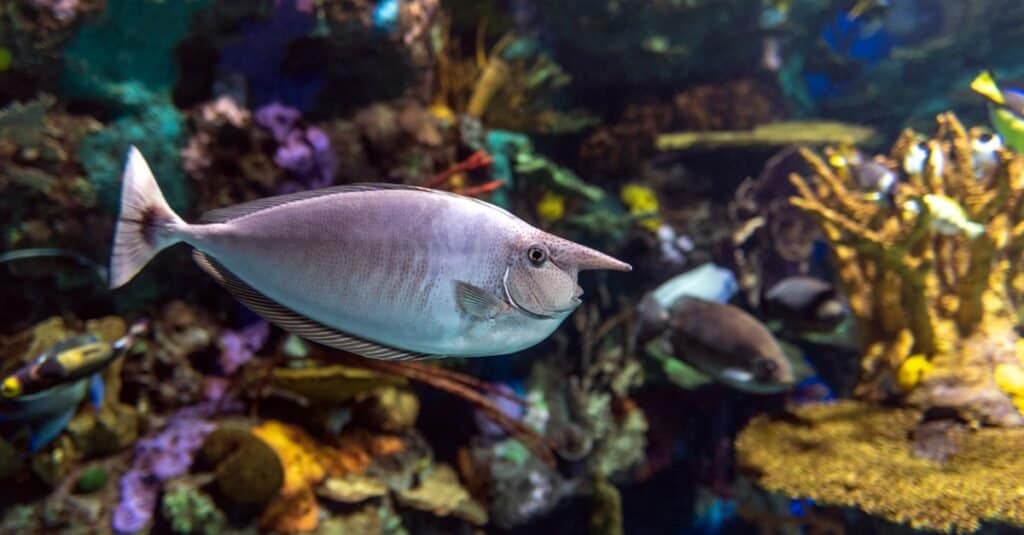
©Miroslav Halama/Shutterstock.com
There are several species of Unicornfish. Some of those species have a horn growing out of the front of their head. Check out this fish from a side view and the horn sort of looks like a nose! Though these fish are named after an imaginary creature, they are very real! Its horn can be as long as 2.5 inches. But keep in mind that this fish’s body can measure two feet long or more. They live in warm, tropical waters off the coasts of Africa and Hawaii. Specifically, they have a coral reef habitat. So, why does a fish need a horn in the ocean?
Unfortunately, scientists have not been able to figure out why Unicornfish have a horn. They know these fish don’t use their horn aggressively. Instead, they have spines on their tailfin they use to defend themselves. They are called tail blades because they are very sharp.
Unicornfish also can change color which can help them blend into their environment when a predator approaches. Though its practical purpose is unclear, its horn has given this fish a cool name!
#3 Rhino-Horned Lizard

©Przemyslaw Skibinski/Shutterstock.com
The rhino-horned lizard is a small reptile measuring several inches long including its tail. This animal has one horn on the end of this creature’s nose is about two-thirds the length of its head. It lives in the trees of Sri Lanka.
Like other animals on this list, scientists are not in agreement on the purpose of this lizard’s horn. It may help these creatures to dig for, capture, and kill the insects in their diet. Or it may discourage predators from catching this lizard and eating it. No matter its purpose, the one horn on a rhino-horned lizard is its most notable feature.
#2 Saola

This small deer can only be found in Vietnam and its existence was discovered just three decades ago in 1992.
©The original uploader was Silviculture at Vietnamese Wikipedia., CC BY-SA 3.0 – License
Have you ever heard of the saola? The answer is probably no. This is because the saola also called the Asian unicorn, is very rarely seen. This small deer can only be found in Vietnam. Its existence was discovered just three decades ago in 1992.
While most deer have two horns or antlers, a saola has just one short horn between its ears on the top of its head. The rarity of this mammal has made it very difficult for scientists to study. So, the purpose of its one horn is unknown. The IUCN Red List of Threatened Species has listed the saola as Critically Endangered.
#1 Narwhal
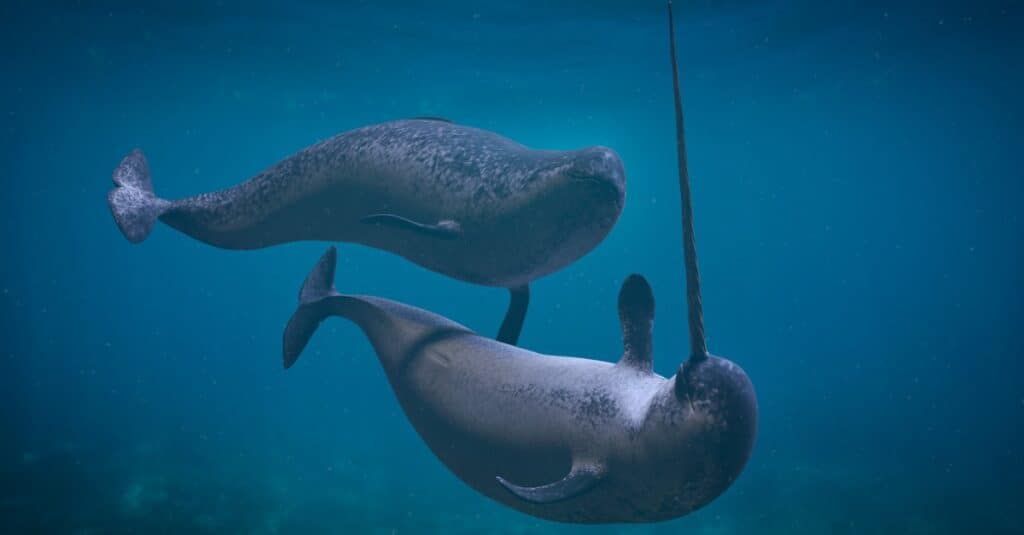
©iStock.com/dottedhippo
When you think of a whale you probably don’t picture one with a spiraled horn sticking out of the front of its head. But that’s exactly what a narwhal looks like. As a note, its one horn is actually a tooth! But, since it looks a lot like a horn, the narwhal has made the list!
Its horn can be up to ten feet in length. Furthermore, these sea creatures can grow to more than 17 feet long and weigh 4200 pounds. They live in frigid, Arctic bodies of water around Greenland, Russia, Norway, and Canada.
Its one horn contains millions of nerve endings that direct a narwhal through Arctic waters as it searches for squid, crabs, fish, and other prey. This way of searching for food is a type of echolocation using its horn to sense what is in its dark environment.
Once the narwhal finds a squid or fish, it sometimes smashes into it with its horn. This stuns the prey long enough for the narwhal to capture it. In addition, a male narwhal uses its horn aggressively when battling with other males for a female during the breeding season. Though it’s mostly males that have this horn, some female narwhals have them, too.
Summary of 8 Animals with One Horn
| Rank | One-Horned Animal |
|---|---|
| 1 | Narwhal |
| 2 | Saola |
| 3 | Rhino-Horned Lizard |
| 4 | Unicornfish |
| 5 | Horned Silkworm |
| 6 | Cassowary |
| 7 | Rhinoceros Beetle |
| 8 | Indian Rhinoceros |
The photo featured at the top of this post is © picassos/Shutterstock.com
Thank you for reading! Have some feedback for us? Contact the AZ Animals editorial team.






